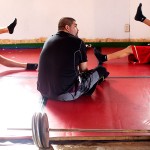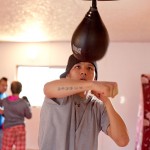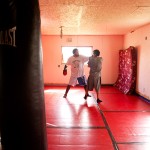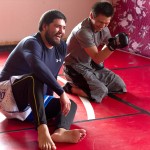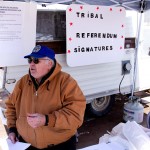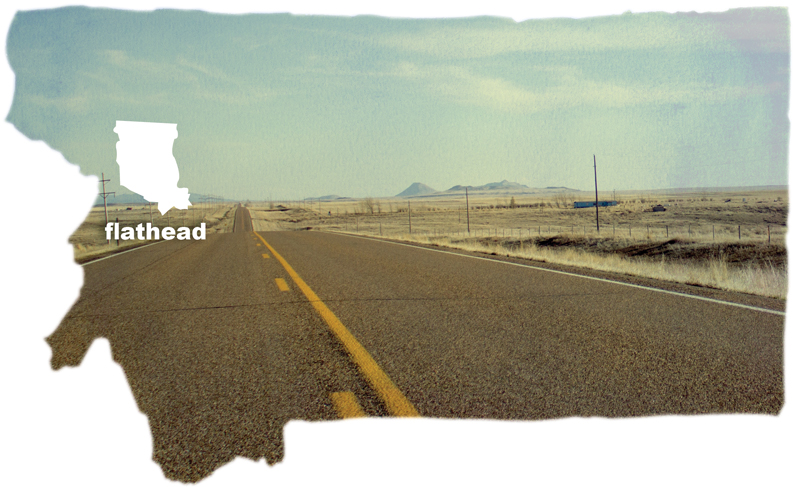Flathead
Flathead – Unsettled
- Alonzo BringsYellow leads a training session at the Fighter’s Island gym. BringsYellow used to be a MMA fighter, but because an injury prevents him from competing, he spends his time training other fighters.
- Boxing gloves rest on a shelf in the Fighter’s Island gym. The gym is operated out of a garage, and members used settlement money to buy gloves and wrestling dummies.
- Sheldon Fisher warms up his arms at the punching bag. Fisher says having the gym in the area gives him an outlet. “It keeps me busy, keeps my mind off of other things,” Fisher said.
- Sheldon Fisher runs from his house to the Fighter’s Island gym, which is housed in a garage.
- Alonzo BringsYellow and Sheldon Fisher spar in the Fighter’s Island gym. Fisher trains here almost every day, preparing for his title fight at the end of the month.
- Cassidy Johnson outside her home in St. Ignatius. Johnson is not a tribal member and did not receive settlement money. But because her husband is enrolled, they used his settlement money to pay bills and buy tires.
- Alonzo BringsYellow, left, takes a break from sparring with Sheldon Fisher, right. BringsYellow is currently training Fisher to compete in an MMA title match at the end of the month.
- The Confederated Salish and Kootenai tribe is expected to take over control of the Kerr Dam on the Flathead reservation from PPL Montana in 2015.
- Elden White explains the petition to tribal member Lanae Keenen. The People’s Voice needs to collect 1,280 signatures before turning the petition into the tribal council.
- Elden White, vice president of the People’s Voice, gathers signatures for a petition outside Pablo Family Foods. The petition proposes a full payout to tribal members from the Salazar settlement.
Story by CARLI KRUEGER
Photographs by ABIGAIL REDFERN
Some would say it was an unwise investment.
But for brothers Jonathan Spotted Eagle and Alonzo BringsYellow, money spent on their makeshift gym is money well spent. Together with another fighter, they run a mixed martial arts club called Fighter’s Island out of Spotted Eagle’s garage. They make no money off of their hobby, but it keeps them and the kids they train out of trouble.
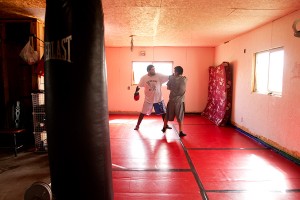
Alonzo BringsYellow and Sheldon Fisher spar in the Fighter’s Island gym. Fisher trains here almost every day, preparing for his title fight at the end of the month.
“Before this, I was drinking in the bars,” said Spotted Eagle, who has since given it up. “[The gym] helps me stay away from that. On the weekend, I can come in here, and by the time I’m done, I’m too tired to do anything.”
The brothers pooled together their resources from an unexpected windfall last year. As members of the Confederated Salish and Kootenai Tribes, they each received money in a major settlement that awarded billions of dollars to 41 tribes across the nation.
Combined with other payments from a separate billion-dollar settlement, 2012 saw an unprecedented injection of money into what is commonly known to be the most impoverished communities in the country. Although the Flathead Indian Reservation, home to the Confederated Salish and Kootenai Tribes, is more economically developed than most western reservations, the influx of cash helped many Salish and Kootenai tribal members pay for expenses that may have previously been unavailable before.
Unfortunately, much of this money was spent off-reservation, largely because of a poor local economy.
“The money [was] probably spent more on non-Indian owned business than the Native-owned business because there are less of them,” said Eleanor YellowRobe, president of Native Assets Accounting in Box Elder and who authored the 2003 study “Uncovering Economic Contributions of Montana’s American Indian Tribes.”
According to that report, the Flathead tribes contributed the largest amount to the state’s economy than any other tribe, spending about $317 million in 2003.
YellowRobe said the 2012 settlement money would have a significant effect on the local economy both on and off the reservation, including bordering towns such as Missoula and Kalispell.
With their settlement, BringsYellow and the brothers Spotted Eagle purchased two new throwing dummies, which cost up to $1,000 apiece. They’ve spent around $3,000 total on the gym over the last two years, picking up mats from old gyms and other equipment when they can.
Salish and Kootenai tribal officials deliberated for almost two years before choosing to distribute half of their $150 million portion of the $1 billion Nez Perce Tribe v. Salazar settlement. This settlement is separate from the Cobell settlement, which was settled in 2012 with its own hefty payout for several tribes across the country. The Salazar settlement was filed in 2006 over the mishandling of tribal resources and funds by the federal government over the past century. The Flathead tribes joined the lawsuit as a plaintiff in 2008.
As a result of the distribution, adult Salish and Kootenai tribal members received $10,000 each. Minors received $5,000 in their Individual Indian Money accounts, and the other $5,000 went to their parents or legal guardians. If tribal members were at all in debt to the tribe, which often finances personal loans, the tribe retained up to $5,000.
The remaining half of the $150 million is in the hands of the tribal government, collecting interest while officials decide how to spend it.
Over time, $4 million of the remaining sum will be paid out to the Native American Rights Fund to compensate for the remaining legal fees incurred in the suit.
Tribal Communications Coordinator Robert McDonald said the council wanted to create a balance by distributing half the money to individuals and saving the rest for other initiatives that will benefit the tribe. The money, he said, will likely go to long-term economic sustainability, culture and language programs, and elder programs, but money has yet to be designated to any specific programs.
Among the discussions for the money include plans to create language instruction and preservation programs. One councilman has an initiative to create a computer font for the Salish and Kootenai languages.
Meanwhile, a group of tribal members has mounted a campaign urging lawmakers to release the remaining money to the public. Such a move would give tribal citizens an additional $8,000 with interest.
Less than a mile from tribal headquarters in Pablo, a sign with yellow and orange balloons directs people to an area beside the nearby grocery store. Members of The People’s Voice Inc. sit under a pop-up tent near a trailer, collecting signatures for two separate petitions.
One of the petitions asks the tribal council to give the public an opportunity to voice its opinion in how to spend the remaining $75 million by way of a public election. The other proposes a change to the tribal constitution allowing tribal members the ability to impeach council members—a privilege only held by fellow council members—and would go to the Bureau of Indian Affairs in Oregon for approval.
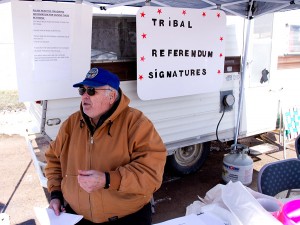
Elden White, vice president of the People’s Voice, gathers signatures for a petition outside Pablo Family Foods. The petition proposes a full payout to tribal members from the Salazar settlement.
Elden White spent the afternoon explaining each petition to curious tribal members. White has a wheeze in his voice and lost some sense of hearing, so people have to lean close to carry a conversation.
As vice president of The People’s Voice, White helps lead the nonprofit, which has advocated for full payout since news of the Salazar settlement broke.
In order to hand the petitions over to the tribal council of the Confederated Salish and Kootenai Tribes, the People’s Voice needed to collect signatures from at least half of the tribe’s eligible voting population, 1,280 signatures in all. After their first weekend, they were only about 100 names shy.
“We’re going to go as long as we can. The more signatures, the more it shows the power of The People’s Voice,” said Sharon Rosenbaum, president of The People’s Voice.
McDonald said he has heard people say the tribe should consider the legacy of the money when it comes to spending it. He said some people believe this money does not just belong to the people who happen to be alive today.
Those same people “don’t want to have to explain down the road to [grandchildren], this money that also belongs to you, went to your auntie,” McDonald said. “A lot of people who are alive today, elders and ancestors, won’t see this money, so there’s been talk about how to honor them.”
The council has remained tightlipped on its plans for the remainder of the settlement money. But that hasn’t stopped tribal citizens from speculating. Some say they thought some of the money was going to go toward expenses on the Kerr Dam, of which the tribe will likely take possession by 2015. There were brief conversations, brought up in two district meetings and one quarterly meeting when the director of energy informally asked the tribe to loan funds for operation costs.
The People’s Voice submitted a similar petition asking for a vote on distributing the remaining money last fall, but the effort was disorganized and many of the signatures were dismissed because of questions of redundancy and how they were obtained.
Still, McDonald said the council would be under no obligation to follow the petition request.
“I don’t think there’s any mechanism for council being forced to take any action because of these signatures,” McDonald said.
Rosenbaum said there’s nothing leading the group to believe they have a better chance at success this time. If the petition fails to spur change again, Rosenbaum said they would try to take the issue to federal court.
Rosenbaum insists the group’s efforts are not all about the money. It’s also about giving tribal members another way to be heard.
“We’re about giving the people a voice to determine how the money is spent,” Rosenbaum said. “This referendum [would] only put it to a vote. That’s what they should have done in the beginning.”
The tribal council holds open meetings weekly and also has time slots available for tribal members to come into the tribal complex and speak with the council about whatever they want. People can also voice their opinions at district and quarterly meetings with the reservation’s lawmakers. McDonald said there is a lot of opportunity for people to speak their minds.
Rosenbaum admits public attendance was low at the council’s recent larger quarterly meeting, where tribal members had the opportunity to voice opinions on the settlement money.
Rosenbaum, who used her $10,000 to clear out rot in her home and pay off a vehicle, said she would be fine without the additional disbursement of the money but other tribal members need it.
“This is a very rich tribe. A lot of money comes in here. But your average tribal member, they’re poor,” she said. “They’re poor people. And it doesn’t need to be that way.”
Like with all of Montana’s tribes, the standard of living for most Salish and Kootenai tribal members is far below national standards.
White, the vice president of The People’s Voice, is building a new deck around his house with his money and sees full payout as an opportunity to improve the day-to-day lives of tribal members.
“We can pay off a lot of our bills,” White said. “Most us on the reservations live from payday to payday. We travel long ways for working on the reservation. We need money for the high gas prices.”
Tribal member Anthony Alexander didn’t sign the petitions but would have liked to have seen the money paid out fully. With more money, he and his wife, a Blackfeet tribal member, would have purchased a home and land.
“We had a place picked out and everything,” his wife, Charnell, said.
Now, Alexander would like to see the money held by the tribe go toward creating more tribal businesses, such as an insurance company, a bakery, a treatment center or an auto-repair shop.
“A lot of these businesses around here aren’t tribally owned, and that’s what I’d like to see,” Alexander said. “We don’t even own any of the stores on Main Street [in Polson].”
Charlene Petet, 68, said she does not want full payout.
“You’ve got to think about tomorrow,” Petet said. “There are things that the tribe needs to leap and spend the money on, and that’s the future. My preference is for the tribe to invest the money and only use the interest so that we would always have the principle.”
Just before the money was paid out, Eagle Bank in Polson saw an increase in the number of checking accounts, likely because direct deposit is easier and quicker than waiting for and cashing paper checks. About six months after the money was doled out, the bank is closing many of those same accounts that have since gone inactive with a zero balance.
A lot of the settlement money went off the reservation and into western Montana. The tribal council conducted an economic impact study about the settlement payout with the University of Montana’s Bureau of Business and Economic Research but hasn’t yet released the report.
Police Capt. Louis Fiddler said there were no significant trends regarding crime, including DUI incidents and deaths, when the settlement money was released. There was a slight increase, he said, but it was comparable to similar instances of cash inflow, like when members receive their $400 per capita checks three times a year, he said.
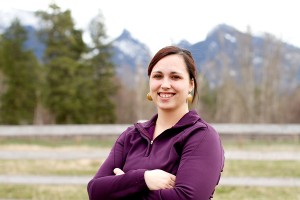
Cassidy Johnson outside her home in St. Ignatius. Johnson is not a tribal member and did not receive settlement money. But because her husband is enrolled, they used his settlement money to pay bills and buy tires.
“We got 10,000, and we spent it wisely for the most part,” White said. “In any society, you’ll have people that’ll squander it, lose it [and] make mistakes.”
On the other hand, the tribal newspaper, the Char-Koosta News, had an influx of advertisements from car dealerships in the surrounding areas and states.
“The reservation was basically like a car parking lot,” said tribal descendant Cassidy Johnson, whose enrolled husband received settlement money. Johnson, although Salish, is not enrolled and couldn’t receive a payment.
“Everyone put their cars up for sale. Deals went out. Actually, I even heard a commercial on the radio from a dealer in Missoula for people to come buy a rig from there and they’d give them so much money for accessories.”
Johnson and her husband, James Lozeau, spent their money mostly on their family. Lozeau works in the tribe’s forestry department, and Johnson attends the Salish Kootenai College, where she is majoring in education. A portion of their money went toward Johnson’s books. The rest of the money was used on bills, birthdays and Christmas.
The enrollment office at the tribal college said they had more students than usual coming in to pay off their student loans after getting their $10,000.
Johnson and Lozeau have two children of their own and one on the way, but also raise their nephew Robert and niece Autumn through tribal kinship. There is no adoption through the CSKT, but Johnson has had Autumn, 3, since she was four months old. At this point, they’ve fostered three of Lozeau’s sister’s six children and hold full custody of two.
As a descendant, Johnson’s biological sons also were ineligible for a payment. Both are just shy of meeting the 25 percent blood quantum needed to enroll in the tribe.
“We’ve been trying to get our two boys enrolled for a long time because they’re, like, a fingernail away from being enrolled, but [the settlement money] wouldn’t have been the reason we’d do that. Basically, if we enrolled our children, it would be because of the educational benefits and scholarships that they would receive.”
However, their nephew Robert and niece Autumn do meet the blood quantum and are enrolled. They received $10,000 each. Because they are not officially adopted, their full $10,000 payments went directly into their Individual Indian Money accounts.
“They’ll have that when they turn 18,” Johnson said. “I want to try and change that so they don’t get it until they’re 22 just because of responsibility.”
Johnson said she thought there were a lot of people on the reservation who didn’t know why they were receiving money. Therefore, she made it a point to educate their 8-year-old nephew about what was going on. They explained why he received his money and where it came from. “We try to teach that to our children, whether they’re tribal or not.”
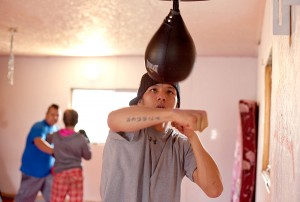
Sheldon Fisher warms up his arms at the punching bag. Fisher says having the gym in the area gives him an outlet. “It keeps me busy, keeps my mind off of other things,” Fisher said.
Though Johnson could not vote in the matter even if she wanted to, she’s not in favor of full payout.
“I’m relieved that it wasn’t split up between everyone,” Johnson said.
Back at Fighter’s Island gym, they’re training, just like they do every Saturday at 2 p.m., teaching each other the art of wrestling, boxing and jiu jitsu. All their knowledge comes from YouTube videos, magazines and, now, some experience.
Inside, a car is parked, taking up a fourth of the space. An assortment of belongings in storage takes up another quarter. The rest is all room to wrestle.
Across mismatched mats pieced together with duct tape, two men grapple. The Montana spring chills the garage enough that their breath surges out in white, frosty puffs. They’re sweating, though, bracing themselves on their knees and pushing against each other with their arms.
“We’re part of the community here in Pablo, and this little area here by the tracks does not have a good reputation,” said BringsYellow, 31, referring to the neighborhood around the gym. “It’s known for people drinking and people doing drugs, people getting stabbed and killed. Bad stuff happens in these tiny neighborhoods over here.
“It’s sad to see, and if we can have a few of those kids walk through our door and say, you know, instead of fighting over there, beating the hell out of each other, [you] can come train here and change your life.”
The brothers will train anyone for free but require their students not to fight outside of the gym and to stay away from drugs and alcohol.
Spotted Eagle and BringsYellow said that if they obtained the full payout, they would use some of it to improve the gym but they don’t want to turn it into a for-profit venture. Rather, they’d like to invite trainers to come in and do seminars, which is something they’ve done in the past.
“We don’t have any professional fighters. Nobody’s a black belt in anything,” BringsYellow said. “This is just all love for the sport.”
Spotted Eagle said he’d like to see the payout because it’d help a lot of families.
“It’d get me back on my bills again, definitely,” he said. “I’d have a lot more money to do things with my kids. I would probably do some things with the gym also. That’s one of the two main goals, if we do get it.”
BringsYellow no longer fights because he has glaucoma and the doctor said he couldn’t afford to get hit in the head anymore.
“There’s no victory for me in fighting anymore,” he said. “My victory is in the kids.”
 Native News Project 2013
Native News Project 2013